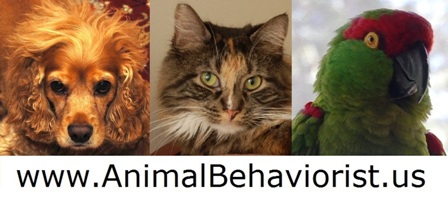| Blended families introducing cats and dogs |
Blended families, introducing cats to dogs and dogs to
cats in your home copyright (c) 2021 Frania Shelley-Grielen. All rights reserved.
Americans, especially urban American like New Yorkers love our pets.
There are cat people and dog people and there are cat and dog people.
And then there are those single pet owners who are thinking about
another pet but are just not sure. Just how well can dogs and cats get
along? Especially if they have not been raised together?
Researchers, N. Feuerstein and Joseph Terkel studied the relationships of
cats and dogs living with humans in an article published in a 2008 edition
of Applied Animal Behaviour Science. The authors’ analyzed questionnaires
distributed to 202 households in Israel and observed cat and dog inter-
actions in 25 of households surveyed. The scientists found, that, yes, cats
and dogs can live “amicably”, read happily, together.
According to the study, cats and dogs are more than adept at reading each
other signals and dogs will even adapt their own greeting behavior to
accommodate the cats in the house. When encountering each other, cats
tend to sniff nose to nose while dogs prefer a nose to tail sniff. When cats
and dogs live together the nose sniff becomes the universal greeting.
Other key points made were that dogs and cats seem to be the most
successful in adapting to each other when the cat is adopted first. Cats
hat are brought into the family before or after a dog, seem to more
readily become accustomed to the dog, whereas when a dog is an
established family member prior to a cat’s introduction the dog may
exhibit greater aggression or indifference to the cat. The reason for
this is thought to be the dog’s greater dependence on humans and what
might look like and perhaps be jealousy on the part of the dog. Don’t
blame the dog though. Human domestication of dogs has created this
trait. Not only do we ask our dogs to work very closely for us as farm
dogs, hunting dogs and service dogs (all heavily dependent on human
direction and interaction). We also breed our dogs for what we consider
acceptable temperament-namely sociability with humans
Cats are famously more independent than dogs. Our domestication of
cats has called mainly for them to rid our grain stores from mice and rats.
Cats are social and do appear to enjoy interacting with humans but also
appear to savor their solitude in a way a dog does not. But then again, the
cat has not been asked to work as closely for humans just to mostly keep
vermin away, coexist and purr.
Not surprisingly, the age of the dog or cat can be a factor as well. Babies
get along well with other babies. The researchers found that cats under
six months of age and dogs less than one year tended to have the lowest
levels of aggression and indifference to each other.
In situations, where the cat or dog is older or the dog is an established
presence, I believe these animals can still share a household as long as
the human involved is willing to take the time to “blend” the family.
Some common sense dictates: keep the animals as separate as possible
initially—new cats should always be introduced by installing them in
a separate room (not the garage) in your home. Allow days to weeks
for a gradual supervised, introduction. Take the time to do
additional research on taking the steps to accomplish this or consult an
animal behavior professional (your local animal shelter might offer
consulting information at no cost). And when travelling with animals
that do not know each other keep the animals separated from each
other initially and only allow for closely supervised visits—your dog
should always stay on a leash and be under your control around a new
cat or dog. Extra consideration, efforts and time may be required in the
introduction process for cats who have not been previously socialized
with dogs and dogs who have not been previously socialized with cats
This article is an original work and is subject to copyright. You may create a
link to this article on another website or in a document back to this web page.
You may not copy this article in whole or in part onto another web page or
document without permission of the author. Email inquiries to
info@animalbehaviorist.us
cats in your home copyright (c) 2021 Frania Shelley-Grielen. All rights reserved.
Americans, especially urban American like New Yorkers love our pets.
There are cat people and dog people and there are cat and dog people.
And then there are those single pet owners who are thinking about
another pet but are just not sure. Just how well can dogs and cats get
along? Especially if they have not been raised together?
Researchers, N. Feuerstein and Joseph Terkel studied the relationships of
cats and dogs living with humans in an article published in a 2008 edition
of Applied Animal Behaviour Science. The authors’ analyzed questionnaires
distributed to 202 households in Israel and observed cat and dog inter-
actions in 25 of households surveyed. The scientists found, that, yes, cats
and dogs can live “amicably”, read happily, together.
According to the study, cats and dogs are more than adept at reading each
other signals and dogs will even adapt their own greeting behavior to
accommodate the cats in the house. When encountering each other, cats
tend to sniff nose to nose while dogs prefer a nose to tail sniff. When cats
and dogs live together the nose sniff becomes the universal greeting.
Other key points made were that dogs and cats seem to be the most
successful in adapting to each other when the cat is adopted first. Cats
hat are brought into the family before or after a dog, seem to more
readily become accustomed to the dog, whereas when a dog is an
established family member prior to a cat’s introduction the dog may
exhibit greater aggression or indifference to the cat. The reason for
this is thought to be the dog’s greater dependence on humans and what
might look like and perhaps be jealousy on the part of the dog. Don’t
blame the dog though. Human domestication of dogs has created this
trait. Not only do we ask our dogs to work very closely for us as farm
dogs, hunting dogs and service dogs (all heavily dependent on human
direction and interaction). We also breed our dogs for what we consider
acceptable temperament-namely sociability with humans
Cats are famously more independent than dogs. Our domestication of
cats has called mainly for them to rid our grain stores from mice and rats.
Cats are social and do appear to enjoy interacting with humans but also
appear to savor their solitude in a way a dog does not. But then again, the
cat has not been asked to work as closely for humans just to mostly keep
vermin away, coexist and purr.
Not surprisingly, the age of the dog or cat can be a factor as well. Babies
get along well with other babies. The researchers found that cats under
six months of age and dogs less than one year tended to have the lowest
levels of aggression and indifference to each other.
In situations, where the cat or dog is older or the dog is an established
presence, I believe these animals can still share a household as long as
the human involved is willing to take the time to “blend” the family.
Some common sense dictates: keep the animals as separate as possible
initially—new cats should always be introduced by installing them in
a separate room (not the garage) in your home. Allow days to weeks
for a gradual supervised, introduction. Take the time to do
additional research on taking the steps to accomplish this or consult an
animal behavior professional (your local animal shelter might offer
consulting information at no cost). And when travelling with animals
that do not know each other keep the animals separated from each
other initially and only allow for closely supervised visits—your dog
should always stay on a leash and be under your control around a new
cat or dog. Extra consideration, efforts and time may be required in the
introduction process for cats who have not been previously socialized
with dogs and dogs who have not been previously socialized with cats
This article is an original work and is subject to copyright. You may create a
link to this article on another website or in a document back to this web page.
You may not copy this article in whole or in part onto another web page or
document without permission of the author. Email inquiries to
info@animalbehaviorist.us
| "Cats that are brought into the family before or after a dog, seem to more readily become accustom- ed to the dog, whereas when a dog is an established family member prior to a cat’s introduction the dog may exhibit greater aggression or indifference to the cat." |

Copyright Frania Shelley-Grielen

copyright Frania Shelley-Grielen

212-722-2509 / 646-228-7813
Website copyright Frania Shelley-Grielen
Website copyright Frania Shelley-Grielen

Best viewed in Google Chrome |